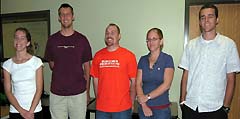 The inaugural edition of the Newsletter from the Sciences Division at Redeemer University College is available for downloading from Fall 2006 Newsletter (4.15mb). Its purpose is to keep you informed of the latest information from the Science students (past and present) and Faculty. This Newsletter will celebrate the activities of the Division, the research projects of faculty members, and the accomplishments of our students.
The inaugural edition of the Newsletter from the Sciences Division at Redeemer University College is available for downloading from Fall 2006 Newsletter (4.15mb). Its purpose is to keep you informed of the latest information from the Science students (past and present) and Faculty. This Newsletter will celebrate the activities of the Division, the research projects of faculty members, and the accomplishments of our students.
Friday, October 20, 2006
Redeemer Science Division Newsletter
 The inaugural edition of the Newsletter from the Sciences Division at Redeemer University College is available for downloading from Fall 2006 Newsletter (4.15mb). Its purpose is to keep you informed of the latest information from the Science students (past and present) and Faculty. This Newsletter will celebrate the activities of the Division, the research projects of faculty members, and the accomplishments of our students.
The inaugural edition of the Newsletter from the Sciences Division at Redeemer University College is available for downloading from Fall 2006 Newsletter (4.15mb). Its purpose is to keep you informed of the latest information from the Science students (past and present) and Faculty. This Newsletter will celebrate the activities of the Division, the research projects of faculty members, and the accomplishments of our students.
Friday, October 6, 2006
Summer Research at Redeemer
 Five students from the Redeemer University College Sciences Division enjoyed an opportunity to pursue a research project in more depth this summer by joining with a professor. The students were all supported by NSERC (Natural Sciences and Engineering Research Council of Canada) and two of the students were also supported by HRSDC (Human Resources Skills and Development Canada Summer Career Placement Program).
Five students from the Redeemer University College Sciences Division enjoyed an opportunity to pursue a research project in more depth this summer by joining with a professor. The students were all supported by NSERC (Natural Sciences and Engineering Research Council of Canada) and two of the students were also supported by HRSDC (Human Resources Skills and Development Canada Summer Career Placement Program).Four of the students received Undergraduate Student Research Awards (USRAs) worth $4500 each, plus additional salary for the summer term. Every year since 1999, Redeemer professors have hired students to join them in summer research under the USRA program of NSERC.
Quite regularly, summer student research has resulted in coauthored publications with Redeemer professors in high quality refereed journals. We expect to see further articles forthcoming based on the success of the research this past summer as well.
Eric Windhorst worked with Dr. Edward Berkelaar to study selenium accumulation by wheat seedlings. Eric grew plants hydroponically, and exposed them to precise amounts of selenium. He then harvested plants and exposure solutions, prepared them for analysis, and analysed them for selenium by graphite furnace atomic absorption spectroscopy.
Art Smit worked with Dr. Derek Schuurman, assisting with research into a robust approach to robot and computer vision for position measurement in the presence of occlusions.
Marieke Van Walderveen worked for Dr. Gary Chiang. She isolated Malpighian tubules (a.k.a., insect kidneys) from different species of insect and measured how much of the organic anion, salicylate, they secreted. This work was done in Dr. Mike O’Donnell’s laboratory at McMaster University.
Loretta VanderSpek also worked at McMaster under the supervision of Dr. Wytse van Dijk and McMaster’s Dr. D.W.L. Sprung. Her project involved a theoretical study of electron transport through layered semiconductors. She looked at such transport when the device or junction was biased by a voltage. Her work included mathematical analysis, computer algebra and programming, and graphical displayof the results.
Matthew West did mathematical research with Dr. Vander Meulen, exploring a relatively new branch of mathematics called qualitative matrix theory. In brief, Matthew explored properties of matrices which are determined by the pattern of nonzero entries in a matrix. His work with Dr. Vander Meulen will be presented at a workshop at the American Institute of Mathematics this month.
Subscribe to:
Posts (Atom)
